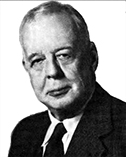
 Alfred Newton Richards
Alfred Newton Richards
1947-1950 NAS President
Jewett was followed as president in 1947 by a research physiologist, Alfred Newton Richards (1876–1966), a close friend of Bronk and also from the University of Pennsylvania. He was quite willing to give Bronk all the leeway he needed to rejuvenate the Academy as a major advisor to the government on scientific matters. This meant sitting on the sidelines while Bronk displayed his typical inspired activity.
Richards had a particularly distinguished career. His father was an impecunious clergyman who sacrificed sufficiently to send him to Yale as an undergraduate. There he was much stimulated by an undergraduate course in chemistry given by Professor R. H. Chittenden. The latter noted his interest and suggested that he continue in graduate work in chemistry. When Chittenden learned of the financial limitations that governed Richards' actions, he arranged a very modest fellowship from Yale that carried Richards through the first graduate year. Fortunately Chittenden obtained an auxiliary appointment at Columbia University and was able to shift Richards to it along with a sequence of better-paying appointments that eventually extended to a professorship in pharmacology in 1903.
Along the way, Richards greatly broadened his knowledge and laboratory skills in several fields. In 1908, he accepted an appointment in the medical school of Northwestern University in Illinois where he began to study the detailed action of drugs. He made the close friendship of Christian Herter and formed links with the newly created Rockefeller Institute for Medical Research in New York. In 1910 he shifted to the medical school of the University of Pennsylvania, which served as his main base until he became emeritus.
He joined the OSRD as head of the Committee on Medical Research in 1941, centering its main offices in the Academy building at 21st and Constitution Avenue. The committee worked in many areas including treatments for tropical diseases and blood substitutes.
When Professor Howard Florey, F.R.S., arrived from England during the war seeking advice on ways to enhance the production of penicillin, which was minuscule at the time, he was faced with a conflict between those who wanted to continue by enhancing production through fermentation and those who preferred experiments on synthesis. Richards strongly advised the first route and put Florey in touch with the Department of Agriculture's Research Laboratory in Peoria, Illinois, where large scale fermentation procedures were being developed. Major pharmaceutical corporations took over from there. His advice proved to be on the mark. Copious quantities of the antibiotic were available by the time of the Normandy invasion in June of 1944.
Continue reading next chapter: Detlev Wulf Bronk

